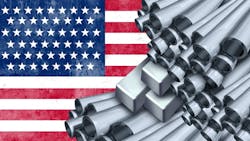Trump tariffs may already be impacting the offshore oil and gas industry
By Bruce Beaubouef, Managing Editor
US President Donald Trump’s recently enacted tariffs are expected to have some level of negative impact on the oil and gas industry in the US Gulf of Mexico (GoM) and even beyond. These impacts are expected to arise from a mix of direct cost pressures, supply chain disruptions and broader economic ripple effects.
These tariffs include a 25% levy on most goods from Canada and Mexico (with a 10% rate on Canadian energy products) and a 10% tariff on Chinese imports, alongside expanded tariffs on steel and aluminum. In turn, these tariffs are expected to have some impacts on the supply chain that feeds offshore E&P. These impacts are detailed below.
Direct cost increases
The offshore oil and gas industry relies heavily on steel for tubulars (casing, tubing, risers) and equipment like platforms and subsea systems. The expanded Section 232 tariffs on steel and aluminum, effective Feb. 10, 2025, have driven up costs significantly. Industry reports indicate that prices for steel pipes—critical for well completions—jumped 15-25% shortly after the tariffs were announced.
For example, hot-rolled coil steel (used in oil country tubular goods, or OCTG) is projected to hit $890 per short ton in 2025, a 15% rise from 2024 averages, per S&P Global Commodity Insights. Offshore wells, which can cost $50 million to $100 million each in the deepwater GoM, typically see OCTG expenses accounting for roughly 8-10% of drilling and completion costs. A 25% steel price hike could add $1 million to $2 million per well, squeezing margins for operators like Chevron or bp, especially with high-cost HP/HT projects like Anchor or Kaskida.
Supply chain challenges
Related content:
Analysis: US Gulf drillship fleet could be heading into rough waters
A looming dip in demand is due to rising project costs and supply chain challenges, according to Westwood.
Canada supplies 16% of US OCTG imports, and Mexico contributes to broader steel and equipment flows. The 25% tariff on Canadian and Mexican goods (with energy at 10%) disrupts this integrated North American supply chain, built under NAFTA and the USMCA. Offshore service firms that source steel-intensive components now face higher input costs or delays if they pivot to domestic suppliers with limited capacity. Comments from industry observers in March seem to echo this, noting a 25% immediate cost increase for casing and tubing, with warnings of reduced drilling activity.
Meanwhile, the 10% tariff on Chinese imports hits equipment like valves, fittings and subsea hardware, where China is a key low-cost supplier. Goldman Sachs suggests these tariffs won’t drastically shift global oil prices short-term, but they do burden US refiners and offshore operators reliant on imported intermediates.
Industry response and production trends
Recently released!
2025 US Gulf of Mexico Map
Offshore highlights crude and natural gas fields in the US Gulf of Mexico as well as pipeline and lease operators.
Bottom line
For producers in the US GoM, Trump’s tariffs are, at the very least, adding uncertainty to an industry already navigating Biden-era leasing limits, pandemic-induced supply chain disruptions and a global energy transition.
The tariffs are expected to add 2-5% to overall project expenses in the US GoM, the result of higher steel and equipment costs, modest fuel price risks, and supply chain friction.
The US GoM’s breakeven price of $47/bbl (down from $68 in 2014) keeps it competitive, but prolonged trade friction could dampen investment appetite. Production growth is expected to continue, but smaller firms might pull back if the trade wars escalate, and long-term investment could soften.
Still, the resilience of E&P programs in the US Gulf — as shown by production levels, which have been growing and are expected to continue to climb — suggests adaptation rather than downturn.
Want more content like this?
If you're interested in how the tariffs are impacting other industries, check out our Endeavor Business Media sister brands' coverage below.
Tariff threats: Energy storage prices could rise 35% or more under hikes | EnergyTech
Opportunities and challenges from tariffs: Production Pulse | IndustryWeek
Navigating the implications of President Trump's tariff plan for the water industry | WaterWorld
Trump tariffs bring angst, uncertainty to mechanical contracting industry | Contractor
How is the fluid power industry responding to tariffs? | Power & Motion
Trade groups condemn latest Trump tariffs | Plastics Machinery & Manufacturing
Pulse report: How US businesses are responding to Trump’s new tariffs
President Trump’s sweeping April 2 tariff announcement is already reshaping how American companies think about supply chains, costs and operational strategy. Endeavor Business Intelligence surveyed more than 400 business leaders across key industries to understand how these changes are being felt on the ground.
This data-rich, fast-read report offers real-time insights to help you benchmark your own position and prepare for what’s ahead.
About the Author
Bruce Beaubouef
Managing Editor
Bruce Beaubouef is Managing Editor for Offshore magazine. In that capacity, he plans and oversees content for the magazine; writes features on technologies and trends for the magazine; writes news updates for the website; creates and moderates topical webinars; and creates videos that focus on offshore oil and gas and renewable energies. Beaubouef has been in the oil and gas trade media for 25 years, starting out as Editor of Hart’s Pipeline Digest in 1998. From there, he went on to serve as Associate Editor for Pipe Line and Gas Industry for Gulf Publishing for four years before rejoining Hart Publications as Editor of PipeLine and Gas Technology in 2003. He joined Offshore magazine as Managing Editor in 2010, at that time owned by PennWell Corp. Beaubouef earned his Ph.D. at the University of Houston in 1997, and his dissertation was published in book form by Texas A&M University Press in September 2007 as The Strategic Petroleum Reserve: U.S. Energy Security and Oil Politics, 1975-2005.

